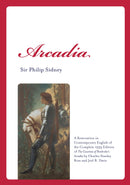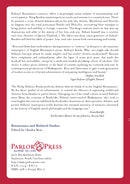



Description
Payment & Security
Your payment information is processed securely. We do not store credit card details nor have access to your credit card information.
We'll send updates on new releases, special events, great deals, freebies, and more. No more than once per month. We don't share your information with anyone.




A Restoration in Contemporary English of the Complete 1593 Edition of The Countess of Pembroke's Arcadia by Charles Stanley Ross and Joel B. Davis, with an Essay on Musical Settings for the Poems by Edward Abe Plough
Renaissance and Medieval Studies
Edited by Charles Stanley Ross
Information and Pricing
Buy the paperback or hardcover and add the PDF for $1!
978-1-60235-858-4 (paperback, $49.99); 978-1-60235-859-1 (hardcover $99.99); 978-1-60235-860-7 (PDF, $29.99); 978-1-64317-549-2 (paperback + PDF, $50.99); 978-1-64317-550-8 (hardcover + PDF, $100.99) © 2017 by Parlor Press. 640 pages with 25 illustrations, notes, bibliography, and appendices
Bookstores: Order by fax, mail, or phone. See our "Sales and Ordering Page" for details.
Richard Wood, Review. The Spenser Review 49.3 (Fall 2019).
"Ross and Davis have undertaken a daring venture: to "restore," as they put it, the immense masterpiece of English Renaissance prose, Sidney's Arcadia. Why, one might ask, should Sidney's baroque syntax be made simpler and his archaic diction modernized? Because their complexity and unfamiliarity, after the lapse of some 400 years, has made the work all but unreadable, except by a small and steadily shrinking cohort of scholars. The choice is either pious oblivion or the kind of creative updating we routinely welcome in contemporary productions of Shakespeare. Ross and Davis want to give a new generation of readers access to a literary achievement of surpassing intelligence and beauty."—Stephen Greenblatt, Cogan Professor of English, Harvard University
"Sir Philip Sidney's Arcadia perfectly defines what we think of as the English Renaissance. By the sheer quality of its achievement, it created the illusion of separating traditional rhetoric from literature or polite letters. Emerging out of the small coterie around Sidney's sister Mary, the countess of Pembroke, Sidney's oeuvre reached Shakespeare, who took to new heights the oratory exhibited by the Arcadia's characters in their speeches, debates, and poetry. Sidney's masterpiecerichly deserves the renewed attention of everyone interested in the history of English moral philosophy and the language arts." —Krista Ratcliffe, Past President, Rhetoric Society of America, Arizona State University
"Most of us don't think of singing Renaissance shepherds as a source of political understanding. But statesmanship is exactly what we find in Sidney's Arcadia. It is one reason, along with Sidney's use of humor and suspense, that this compelling story was the most popular work of English narrative prose for over two hundred years. Modern-day public servants might benefit as Shakespeare did in borrowing widely from Arcadia's lessons on virtue, popular rebellion and the perils of misrule." —Mitchell E. Daniels, Jr., President of Purdue University and Former Governor of Indiana
Sidney's Arcadia was the most popular and most important work of English prose fiction for over two hundred years. In it we find the name Pamela, Sidney's invention. Shakespeare read every word. Not himself in the corridors of power as Sidney was, Shakespeare borrowed the way Sidney's prose and poetry expresses strong emotion controlled by thought. He also modeled characters on those in the Arcadia. Gloucester in King Lear is modeled on Sidney's blind Paphlagonian king. Philoclea's bewilderment at her love for Pyrocles becomes Juliet's performance when Romeo appears beneath her balcony.
Sidney's Renaissance romance also offers a surprisingly astute analysis of statesmanship that prefigures Shakespeare's history plays. When Basilius misinterprets an oracle and retreats to his country house, he pursues a cross-dressed Amazon whom his wife also desires. Musidorus and Pyrocles in disguise woo the royal princess Pamela and Philoclea by recounting their attempts to bring justice and stability to foreign countries. The king's envious sister-in-law stirs up dissensions and adds to the misery of her love-sick son Amphialus. Sidney himself was a courtier and close observer of Queen Elizabeth I. His father was three times governor of Ireland. Readers will find this fable of power, erotic passion, and civic unrest both entertaining and timely.
Sir Philip Sidney was an English poet, courtier, scholar, and soldier. He is remembered as one of the most prominent figures of the Elizabethan age.
Charles Ross is Professor of English and Director of the Comparative Literature Program at Purdue University. His books include the first English translation of Matteo Maria Boiardo’s romance Orlando Innamorato and a verse translation of L. Paninius Statius’s Thebaid. He is the author of The Custom of the Castle from Malory to Macbeth as well as Elizabethan Literature and the Law of Fraudulent Conveyance: Sidney, Spenser, Shakespeare. He is the series editor of Parlor Press's Renaissance and Medieval Studies series.
Joel B. Davis is Nell Carlton Professor of English at Stetson University in DeLand, Florida. His most recent book is The Countesse of Pembroke's Arcadia and the Invention of English Literature (2011). He has published on Philip, Robert, Mary, and Henry Sidney, in Studies in Philology, The Sidney Journal, and The Ashgate Research Companion to the Sidneys, 1500-1700, and his essays on Shakespeare, Robert Greene, Garcilaso de la Vega, and Sir Thomas Wyatt can be found in Papers on Language and Literature and Studies in Philology.
Your payment information is processed securely. We do not store credit card details nor have access to your credit card information.
Most books may be returned by retailers for full credit within 180 days of the date of the original invoice (see below for return policies for open access Titles" for the exceptions"). Books must be in resalable condition for full credit. Credit cannot be given for books that cannot be resold. Permission is unnecessary with invoice and prepaid return.
Return Address: Parlor Press, 3015 Brackenberry Drive, Anderson, SC 29621 (UPS, FedEx, or US Mail)
Please use our website contact form, call 765.409.2649, or email sales@parlorpress.com with questions.
Parlor Press publishes a large number of titles that are available online for free and also in low-cost print versions. So that we can continue to offer these titles in free online editions, we require that orders for printed copies be paid for at the time of purchase and may not be returned (unless damaged in transit). Bookstores should be aware that many instructors don't require printed versions of these titles or, even when they do, students use the free online versions. So adjust order quantities carefully! If you have questions about whether a specific title is returnable, please use our website contact form, call 765.409.2649, or email sales@parlorpress.com
If physical books, journals, magazines, comics, CDs, or DVDs you purchase from our website are damaged when you receive them, you can return them for replacement or a refund for up to thirty (30) days. Please use the site's contact form to let us know if there are any other issues of if you're not sure an item can be returned. If 30 days have gone by since your purchase, unfortunately we can’t offer you a refund or exchange.
Other physical items that you might purchase and that aren't consumable content (like a book or journal) may be returned for up to thirty (30) days for credit or a refund. To be eligible for a return, your item must be unused and in the same condition that you received it. It must also be in the original packaging.
We do not offer returns on physical books that are undamaged, ebook purchases (in PDF or EPUB format), gift cards, or other downloadable products.
To complete your return, we require a receipt or proof of purchase.
Please do not send your purchase back to the manufacturer.
Refunds (if applicable)
Once your return is received and inspected, we will send you an email to notify you that we have received your returned item. We will also notify you of the approval or rejection of your refund. If approved, then your refund will be processed, and a credit will automatically be applied to your credit card or original method of payment, within ten days.
Late or missing refunds (if applicable)
If you haven’t received an expected refund, first check your bank or card account again. It may take some time before your refund is officially posted. If you’ve done all of this and you still have not received your refund, please contact us via our site contact form.
Sale items (if applicable)
Only regular priced items may be refunded. Unfortunately sale items cannot be refunded.
Exchanges (if applicable)
We only replace items if they are defective or damaged. If you need to exchange it for the same item, use our site contact form and then send your the items to Parlor Press LLC, 3015 Brackenberry Drive, Anderson SC 29621, United States.
Gifts
If the item was marked as a gift when purchased and shipped directly to you, you’ll receive a gift credit for the value of your return. Once the returned item is received, a gift card code will be emailed to you.
If the item wasn’t marked as a gift when purchased, or the gift giver had the order shipped to themselves to give to you later, the refund will go to the gift giver, who will find out about your return.
Shipping
To return your product, you should mail it to Parlor Press LLC, 3015 Brackenberry Drive, Anderson SC 29621, United States
You will be responsible for paying for your own shipping costs for returning your item. Shipping costs are nonrefundable.
If you are shipping an item over $75, you should consider using a trackable shipping service or purchasing shipping insurance. We can't guarantee that we will receive your returned item.
We deliver worldwide.
We can ship from our distributors around the world.
Fast shipping
Most orders are processed within 24 hours.
Question about a book, series, author, or anything else?
Use our contact form to ask away.
Secure payments
All purchases are secure and private.
